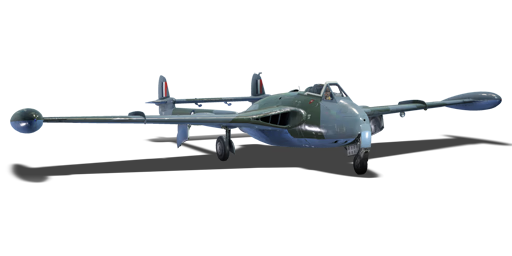



In 1948, de Havilland began working on an improved development of their first jet aircraft, the Vampire. While initially envisioned as the Vampire FB.8, a new Air Ministry specification was issued calling for an interim fast, manoeuvrable fighter-bomber that could bridge the gap between the Vampires and Meteors in RAF service and pioneering new designs such as the Hawker Hunter and Supermarine Swift; thus, while visually similar to the preceding Vampire, an entirely new design was created and designated the Venom, notably featuring the significantly more powerful de Havilland Ghost engine. The prototype took its first flight in September 1949, and the type entered operational service in 1952. The FB.4 variant was the last operated by the RAF, modified from the FB.1 to fit ejector seats, surface modifications, and hydraulically powered ailerons.
Introduced in Update 1.43, the Venom retains the great manoeuvrability of the Vampire, while also being equipped with a significantly more powerful engine, allowing it to fight more equally against common opponents in both energy and manoeuvrability-dependent situations. However, with the emergence of increasingly powerful opponents, some even equipped with afterburning engines, the Venom will tend to fall back on the same playstyle as the Vampire, maintaining its speed by default, but baiting, turning with, and gunning down lone enemies when the opportunity arises.
flaps
flaps
flaps
brake
| Belt | Belt filling | Armor penetration (mm) at a distance: | |||||
|---|---|---|---|---|---|---|---|
| 10 m | 100 m | 500 m | 1000 m | 1500 m | 2000 m | ||
| HEI/SAP-I/T | 21 | 19 | 14 | 9 | 5 | 4 | |
| AP-T/HEI/SAP-I | 36 | 33 | 24 | 15 | 10 | 7 | |
| SAP-I/HEI/AP-T/HEI/SAP-I | 36 | 33 | 24 | 15 | 10 | 7 | |
| AP-T/HEI/T | 36 | 33 | 24 | 15 | 10 | 7 | |
| AP-T/SAP-I/HEI/AP-T | 36 | 33 | 24 | 15 | 10 | 7 | |
| HEI/SAP-I | 22 | 20 | 14 | 9 | 6 | 4 | |
4 × RP-3 rockets
4 × RP-3 rockets
4 × RP-3 rockets
4 × RP-3 rockets
4 × RP-3 rockets












Flight performance | |
|---|---|
Survivability |
|---|
Weaponry | |
|---|---|